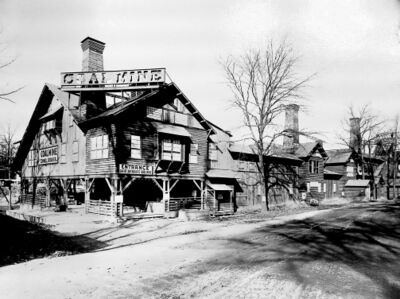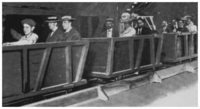Coal Mine: Difference between revisions
No edit summary |
No edit summary |
||
| (One intermediate revision by the same user not shown) | |||
| Line 1: | Line 1: | ||
{{short description|Great Anthracite Coal Mine}} | {{short description|Great Anthracite Coal Mine}} | ||
{{Infobox | {{Infobox FairBuilding | ||
| name = Great Anthracite Coal Mine | | name = Great Anthracite Coal Mine | ||
| image = Great Anthracite Coal Mine. | | image = Great Anthracite Coal Mine.jpg | ||
| image_size = | | image_alt = | ||
| image_size = 400px | |||
| caption = Great Anthracite Coal Mine | | caption = Great Anthracite Coal Mine | ||
| alternate_name = | | alternate_name = | ||
| | | location = [[Mining Gulch]] | ||
| | | no_buildings = 1 | ||
| | | construction_cost= | ||
| | | furnishing_cost = | ||
| profit = | |||
| profit = | |||
| owner = | | owner = | ||
| | | architect = | ||
| | | dimensions = | ||
| | | adult_entry = 25¢ (${{Inflation|US|.25|1904}} in {{Inflation/year|US}}) | ||
| child_entry = | |||
| opening_day = | |||
| dedication_day = | |||
| special_day = | |||
| other = | | other = | ||
}} | }} | ||
| Line 22: | Line 26: | ||
==Before the Fair== | ==Before the Fair== | ||
In 1902, coal production boomed, and added up to 350,000,000 short tons of mined coal. Working conditions were poor, with many accidents occurring. John Mitchell lead the Anthracite Coal Mine Strike of 1902, which, resulted in President Roosevelt intervening and increasing workers wages by 10%. This brought the working conditions of coal miners to the attention of the public. | |||
Some early (pre-Fair) maps show this concession was to be located on [[The Pike]]. | Some early (pre-Fair) maps show this concession was to be located on [[The Pike]]. | ||
==Description== | ==Description== | ||
[[File:Coal Mine Carts.png|200px|thumb|left|Visitors in the coal mine cars.]] | |||
Upon entering the dark ride, visitor are seated in a tram car, the exact size and make of those used in the mines, then make a circuit through 1,260 feet through darkened tunnels, lined with huge blocks of simulated coal. Throughout the ride were eight scenes illustrating coal mining displayed along the ride.<ref>Mary C. Dorris "Mining Gulch at Great World's Fair." ''Nashville Banner''. 21 Sep. 1904, p. 8.</ref> | |||
* The miners entering the mine, with their dinner pail, pick and shovel. | |||
* Men at work dumping the coal which has just been mined into the chute to be crushed. | |||
The | * Boys (14-20 years old) are engaged picking out the slate from the crushed coal and throwing it aside. | ||
* Men eating their lunch 1,000 feet below the surface. | |||
* Mules living their completely underground, being fed and shod, their task to pull mine carts. | |||
* A terrible explosion caused by fire-damp, when men and mules are killed and covered with debris, while half a dozen men in the water and only one rescue bucket lowered to them in which each will take his turn. | |||
* An emergency doctor and nurse summoned to a man caught in an accident. | |||
* The last scene depicted the miner's going home. | |||
After the cart ride, visitors could examine an exhibit which included: 4 relief maps that occupied 100 sq. feet, a model of a mine, a working model of a breaker (which could separate the coal from shale), and a wash recovery station. Souvenirs made of the hard coal were also available for purchase. | |||
There was also a coal-themed restaurant. | |||
==After the Fair== | ==After the Fair== | ||
| Line 44: | Line 53: | ||
==References== | ==References== | ||
<references /> | |||
==External links== | ==External links== | ||
Latest revision as of 05:01, 24 November 2022
 | |
| Location | Mining Gulch |
|---|---|
| No. of Buildings | 1 |
| Entry | |
| Adult Entry | 25¢ ($8 in 2021) |
Near the Inside Inn, in the Mining Gulch, was a dark ride attraction simulating a coal mine.
Before the Fair[edit | edit source]
In 1902, coal production boomed, and added up to 350,000,000 short tons of mined coal. Working conditions were poor, with many accidents occurring. John Mitchell lead the Anthracite Coal Mine Strike of 1902, which, resulted in President Roosevelt intervening and increasing workers wages by 10%. This brought the working conditions of coal miners to the attention of the public.
Some early (pre-Fair) maps show this concession was to be located on The Pike.
Description[edit | edit source]

Upon entering the dark ride, visitor are seated in a tram car, the exact size and make of those used in the mines, then make a circuit through 1,260 feet through darkened tunnels, lined with huge blocks of simulated coal. Throughout the ride were eight scenes illustrating coal mining displayed along the ride.[1]
- The miners entering the mine, with their dinner pail, pick and shovel.
- Men at work dumping the coal which has just been mined into the chute to be crushed.
- Boys (14-20 years old) are engaged picking out the slate from the crushed coal and throwing it aside.
- Men eating their lunch 1,000 feet below the surface.
- Mules living their completely underground, being fed and shod, their task to pull mine carts.
- A terrible explosion caused by fire-damp, when men and mules are killed and covered with debris, while half a dozen men in the water and only one rescue bucket lowered to them in which each will take his turn.
- An emergency doctor and nurse summoned to a man caught in an accident.
- The last scene depicted the miner's going home.
After the cart ride, visitors could examine an exhibit which included: 4 relief maps that occupied 100 sq. feet, a model of a mine, a working model of a breaker (which could separate the coal from shale), and a wash recovery station. Souvenirs made of the hard coal were also available for purchase.
There was also a coal-themed restaurant.
After the Fair[edit | edit source]
See also[edit | edit source]
Notes[edit | edit source]
References[edit | edit source]
- ↑ Mary C. Dorris "Mining Gulch at Great World's Fair." Nashville Banner. 21 Sep. 1904, p. 8.
